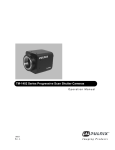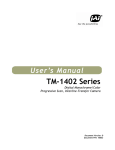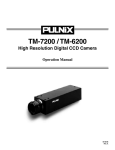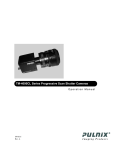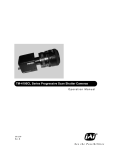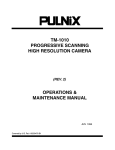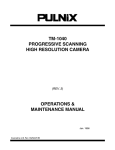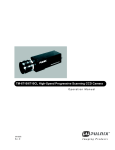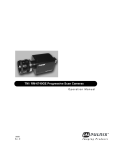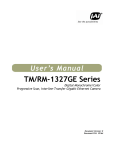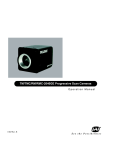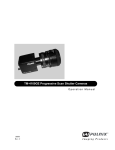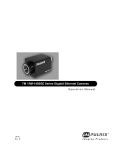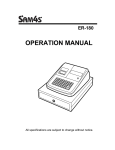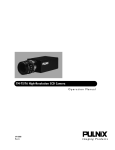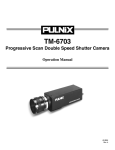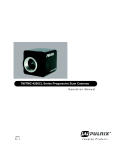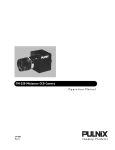Download JAI TM-2016-8/8CL User's Manual
Transcript
TM-2016-8/8CL Progressive Scan Shutter Cameras Operation Manual 69-0093 Rev. B Page ii Page iii Notice The material contained in this manual consists of information that is proprietary to JAI, Inc., and may only be used by the purchasers of the product. JAI, Inc. makes no warranty for the use of its product and assumes no responsibility for any errors which may appear or for damages resulting from the use of the information contained herein. JAI, Inc. reserves the right to make changes without notice. Microsoft, Windows 98, Windows 95, Windows NT, and Windows Explorer are either registered trademarks or trademarks of Microsoft Corporation in the United States and/or other countries. Warranty All of our solid-state cameras have a full three-year warranty. If any such product proves defective during this warranty period, JAI, Inc. will repair the defective product without charge for parts and labor or will provide a replacement in exchange for the defective product. This warranty shall not apply to any damage, defect or failure caused by improper use or inadequate maintenance. Certifications CE Compliance The TM-2016-8/8CL camera has been certified to conform to the requirements of Council Directive 89/336/EEC, 92/31/EEC, and 93/42/EEC for electromagnetic compatibility and to comply with the following European Standards: Immunity: Emissions: EN 55024: 1998 EN 55022: 1998/ CISPR22: 1997 Class A All JAI, Inc. products bearing the CE mark have been declared to be in conformance with the applicable EEC Council Directives. However, certain factory-installed options or customer-requested modifications may compromise electromagnetic compatibility and affect CE compliance. Please note that the use of interconnect cables that are not properly grounded and shielded may affect CE compliance. Contact JAI, Inc. Applications Engineering Department for further information regarding CE compliance. FCC UL ® I ST SS O CIA TI O N RM FILE # A3942 REG MEMBER A FI TED IM MA O NG GI A AU T This equipment has been tested and found to comply with the limits for a Class A digital device, pursuant to Part 15 of the FCC Rules. These limits are designed to provide reasonable protection against harmful interference when the equipment is operated in a commercial environment. This equipment generates, uses and can radiate radio frequency energy and, if not installed and used in accordance with the instruction manual, may cause harmful interference to radio communications. Operation of this equipment in a residential area may cause harmful interference, in which case the user will be required to correct the interference at his own expense. ERED JAI, INC. ISO-9001 Page iv WARNING Changes or modifications to this unit not expressly approved by the party responsible for FCC compliance could void the user’s authority to operate the equipment. TM-2016-8/8CL Operation Manual JAI, Inc. 625 River Oaks Parkway San Jose, CA 95134 Tel:(408) 383-0300 Tel:(800) 445-5444 Fax:(408) 383-0301 E-mail: [email protected] www.jai.com Page v Table of Contents Table of Contents . . . . . . . . . . . . . . . . . . . . . . . . . . . . . . . . . . . . . . . . . . v List of Figures. . . . . . . . . . . . . . . . . . . . . . . . . . . . . . . . . . . . . . . . . . . . vii List of Tables. . . . . . . . . . . . . . . . . . . . . . . . . . . . . . . . . . . . . . . . . . . . . ix 1 Introduction 1.1 1.2 1.3 1.4 . . . . . . . . . . . . . . . . . . . . . . . . . . . . . . . . . . . . . . .1 Product Description . . . . . . . . . . . . . . . . . . . . . . . . . . . . . . . . . . . . . .1 Features . . . . . . . . . . . . . . . . . . . . . . . . . . . . . . . . . . . . . . . . . . . . . . . .2 Functional Options . . . . . . . . . . . . . . . . . . . . . . . . . . . . . . . . . . . . . . .3 System Configuration . . . . . . . . . . . . . . . . . . . . . . . . . . . . . . . . . . . . .4 2 Installation . . . . . . . . . . . . . . . . . . . . . . . . . . . . . . . . . . . . . . . .5 2.1 Getting Started . . . . . . . . . . . . . . . . . . . . . . . . . . . . . . . . . . . . . . . . . .5 2.1.1 Unpacking Instructions . . . . . . . . . . . . . . . . . . . . . . . . . . . . . . . . . . . . . . . . . .5 2.1.2 Components List . . . . . . . . . . . . . . . . . . . . . . . . . . . . . . . . . . . . . . . . . . . . . . .5 2.1.3 Accessories and Options . . . . . . . . . . . . . . . . . . . . . . . . . . . . . . . . . . . . . . . . .5 2.2 Camera Setup 2.2.1 2.2.2 2.2.3 2.2.4 2.2.5 2.2.6 2.2.7 2.2.8 2.2.9 . . . . . . . . . . . . . . . . . . . . . . . . . . . . . . . . . . . . . . . . . . .5 Heat Dissipation . . . . . . . . . . . . . . . . . . . . . . . . . . . . . . . . . . . . . . . . . . . . . . .5 Connector Pin Configurations . . . . . . . . . . . . . . . . . . . . . . . . . . . . . . . . . . . .6 Shutter Speed Control Dial (TM-2016-8 only) . . . . . . . . . . . . . . . . . . . . . .10 RS-232 Communication Cable (TM-2016-8 only) . . . . . . . . . . . . . . . . . . . .10 Digital Output Cable (TM-2016-8 only) . . . . . . . . . . . . . . . . . . . . . . . . . . .11 Camera Link Cable (TM-2016-8CL only) . . . . . . . . . . . . . . . . . . . . . . . . . .12 Power Supplies and Power Cable Setup . . . . . . . . . . . . . . . . . . . . . . . . . . . .12 Attaching the Analog Video Output . . . . . . . . . . . . . . . . . . . . . . . . . . . . . . .14 Attaching the Camera Lens . . . . . . . . . . . . . . . . . . . . . . . . . . . . . . . . . . . . . .14 3 Operation . . . . . . . . . . . . . . . . . . . . . . . . . . . . . . . . . . . . . . . . 15 3.1 Camera Rear Panel (TM-2016-8) 3.1.1 3.1.2 3.1.3 3.1.4 3.1.5 3.1.6 . . . . . . . . . . . . . . . . . . . . . . . . . . .15 Up/Down Switch . . . . . . . . . . . . . . . . . . . . . . . . . . . . . . . . . . . . . . . . . . . . .15 Digital Output Connector . . . . . . . . . . . . . . . . . . . . . . . . . . . . . . . . . . . . . . .15 Analog Output Connector . . . . . . . . . . . . . . . . . . . . . . . . . . . . . . . . . . . . . . .15 Power, RS-232, and External Sync Connector . . . . . . . . . . . . . . . . . . . . . . .15 Shutter Speed Control Switch . . . . . . . . . . . . . . . . . . . . . . . . . . . . . . . . . . . .15 Mode Selection Switch . . . . . . . . . . . . . . . . . . . . . . . . . . . . . . . . . . . . . . . . .15 3.2 Camera Link Rear Panel (TM-2016-8CL) . . . . . . . . . . . . . . . . . . . .16 3.2.1 Digital Output Connector . . . . . . . . . . . . . . . . . . . . . . . . . . . . . . . . . . . . . . .16 3.2.2 Analog Output Connector . . . . . . . . . . . . . . . . . . . . . . . . . . . . . . . . . . . . . . .17 3.2.3 Power and External Sync Connector . . . . . . . . . . . . . . . . . . . . . . . . . . . . . .17 3.3 3.4 3.5 3.6 Progressive Scanning . . . . . . . . . . . . . . . . . . . . . . . . . . . . . . . . . . . .18 Electronic Shutter . . . . . . . . . . . . . . . . . . . . . . . . . . . . . . . . . . . . . . .18 Integration . . . . . . . . . . . . . . . . . . . . . . . . . . . . . . . . . . . . . . . . . . . . .19 Asynchronous Reset . . . . . . . . . . . . . . . . . . . . . . . . . . . . . . . . . . . . .19 3.6.1 External VINIT With Pulse Width . . . . . . . . . . . . . . . . . . . . . . . . . . . . . . . .19 3.6.2 No Delay Shutter and Read-out-inhibit (ROI) . . . . . . . . . . . . . . . . . . . . . . .20 3.6.3 Internal Shutter Speed Control . . . . . . . . . . . . . . . . . . . . . . . . . . . . . . . . . . .21 3.7 Dynamic Range Control . . . . . . . . . . . . . . . . . . . . . . . . . . . . . . . . .22 Table of Contents Page vi 3.7.1 Programmable Look-Up Table (LUT) and Knee Control 3.8 Scan Modes . . . . . . . . . . . . . . 22 . . . . . . . . . . . . . . . . . . . . . . . . . . . . . . . . . . . . . . . . . . . 23 3.8.1 Full Progressive Scan . . . . . . . . . . . . . . . . . . . . . . . . . . . . . . . . . . . . . . . . . . 23 3.8.2 Two-Row Binning . . . . . . . . . . . . . . . . . . . . . . . . . . . . . . . . . . . . . . . . . . . . 23 3.9 External Sync and Pixel Locking . . . . . . . . . . . . . . . . . . . . . . . . . . . 23 3.10 Camera Timing Charts . . . . . . . . . . . . . . . . . . . . . . . . . . . . . . . . . . . 24 3.10.1 Pixel Clock Locking (optional) . . . . . . . . . . . . . . . . . . . . . . . . . . . . . . . . . . 26 3.11 Serial Communication Kit (TM-2016-8) 4 Troubleshooting . . . . . . . . . . . . . . . . . . . . . 26 . . . . . . . . . . . . . . . . . . . . . . . . . . . . . . . . . . . 27 4.1 Problems and Solutions . . . . . . . . . . . . . . . . . . . . . . . . . . . . . . . . . . 27 4.1.1 Symptom: No Video . . . . . . . . . . . . . . . . . . . . . . . . . . . . . . . . . . . . . . . . . . . 27 4.1.2 Symptom: Dark Video . . . . . . . . . . . . . . . . . . . . . . . . . . . . . . . . . . . . . . . . . 27 4.1.3 Symptom: Non-synchronized Video . . . . . . . . . . . . . . . . . . . . . . . . . . . . . . 27 4.2 Information and Support Resources 5 Appendix . . . . . . . . . . . . . . . . . . . . . . . . . 28 . . . . . . . . . . . . . . . . . . . . . . . . . . . . . . . . . . . . . . . . 29 5.1 Specifications . . . . . . . . . . . . . . . . . . . . . . . . . . . . . . . . . . . . . . . . . . 29 5.1.1 Physical Dimensions . . . . . . . . . . . . . . . . . . . . . . . . . . . . . . . . . . . . . . . . . . 30 5.1.2 Spectral Response . . . . . . . . . . . . . . . . . . . . . . . . . . . . . . . . . . . . . . . . . . . . . 31 Table of Contents Page vii List of Figures FIGURE 1. TM-2016-8 System Configuration . . . . . . . . . . . . . . . . . . . . . . . . . . . . . . . .4 FIGURE 2. Camera Link System Configuration FIGURE 3. Rear Panel View of Digital Connector FIGURE 4. Serial Communication Cable RS-232B-12 FIGURE 5. Pinout Configuration for Digital Output Cable FIGURE 6. 12P-02S Interface Cable (optional) FIGURE 7. Look-Up Table FIGURE 8. Physical Dimensions (TM-2016-8) FIGURE 9. Physical Dimensions (TM-2016-8CL) FIGURE 10. Spectral Response . . . . . . . . . . . . . . . . . . . . . . . . . . . . . .4 . . . . . . . . . . . . . . . . . . . . . . . . . . . . .7 . . . . . . . . . . . . . . . . . . . . . . . . . 10 . . . . . . . . . . . . . . . . . . . . . . 11 . . . . . . . . . . . . . . . . . . . . . . . . . . . . . . . 13 . . . . . . . . . . . . . . . . . . . . . . . . . . . . . . . . . . . . . . . . . . . . . . . 23 . . . . . . . . . . . . . . . . . . . . . . . . . . . . . . . 30 . . . . . . . . . . . . . . . . . . . . . . . . . . . . 30 . . . . . . . . . . . . . . . . . . . . . . . . . . . . . . . . . . . . . . . . . . . . 31 List of Figures Page viii List of Figures Page ix List of Tables TABLE 1. 12-Pin Connector (TM-2016-8) . . . . . . . . . . . . . . . . . . . . . . . . . . . . . . . . .6 TABLE 2. 12-Pin Connector (TM-2016-8CL) TABLE 3. 31-Pin Connector (MP211-031-113-4300) TABLE 4. Connector and Pinout Configurations TABLE 5. Shutter Speed Control Dial TABLE 6. Mode Selection Switch TABLE 7. TM-2016-8 and TM-2016-8CL Product Specifications Table . . . . . . . . . . . . . . . . . . . . . . . . . . . . . .7 . . . . . . . . . . . . . . . . . . . . . . . .8 . . . . . . . . . . . . . . . . . . . . . . . . . . . .9 . . . . . . . . . . . . . . . . . . . . . . . . . . . . . . . . . . . 10 . . . . . . . . . . . . . . . . . . . . . . . . . . . . . . . . . . . . . . 16 . . . . . . . . 29 List of Tables Page x List of Tables May 31, 2007 TM-2016-8 and TM-2016-8CL Progressive Scan Shutter Camera Operation Manual 1 Introduction 1.1 Product Description The JAI, Inc. TM-2016-8* is a high-resolution, high-speed monochrome progressive scan CCD camera. The interline-transfer type CCD permits full vertical and horizontal resolution of very high speed shutter images and applications. The electronic shutter, which has speeds to 1/8,000 sec., can be reset asynchronously by external pulse control. The frame rate is 8 fps. The TM-2016-8 has a full dynamic range control function, which can be set at externally selectable look-up table (LUT) knee slopes to convert 10-bit input to 8-bit output, thereby optimizing the CCD’s full dynamic range in the normal output signal range. The camera has an 8-bit, RS-644 digital signal output for interfacing with external image-processing systems. All the key functions are externally controlled via RS-232C. The TM-2016-8CL model has a Camera Link output. Multi-camera operation requires synchronized data and clock phases from each camera. The TM-20168 has a pixel clock locking phase lock loop (PLL) for multi-camera operation that is offered as an option. † Applications for the TM-2016-8 include machine vision, medical imaging, intelligent transportation systems, high-definition graphics, on-line inspection, gauging, character reading, archiving, and highsecurity surveillance. *. Unless specifically mentioned, all information in this manual is relevant to the TM-2016-8, TM2016-8CL, RM-2016-8 and the RM-2016-8CL cameras. †. Pixel clock locking option not available at time of publishing. Please check with JAI, Inc. for option availability. TM-2016-8 and TM-2016-8CL Progressive Scan Shutter Camera Page 2 TM-2016-8 and TM-2016-8CL Progressive Scan Shutter Camera 1.2 Features • Miniaturized and lightweight The printed circuit boards in the TM-2016-8 have been arranged based on a new design philosophy that creates modular electronics for the camera, giving it flexibility. In addition, the use of miniature solid-state components results in a compact, lightweight camera that is 44mm x 44mm x 64mm in dimensions, and weighs only 136 grams (CL version 141 grams). • Imager The TM-2016-8 uses a progressive scan interline transfer CCD that has the following features: - Resolution of 1920 x 1080 active pixels for excellent image quality. - 7.4 x 7.4 µm square pixels for precise dimensional measurement. - High-speed electronic shutter capability for high dynamic resolution of moving objects and electronic iris control that eliminates the need for a mechanical shutter. - Progressive scan CCD eliminates interlace deterioration of image and increases ease of computer interface. - High sensitivity and low noise at fast scanning. The CCD can drive faster than 20 MHz pixel clock rate and has an excellent S/N ratio that is greater than 60dB. - Built-in microlenses. • Electronic shutter The TM-2016-8 has a substrate drain-type shutter mechanism which provides superb pictures at various speeds without smearing. A built-in manual shutter speed control selects the electronic shutter rate of 1/30 (non-async mode only), 1/60, 1/125, 1/280, 1/500, 1/1,000, 1/2,000, 1/4,000, and 1/8,000 second. The CCD discharges at a high VINIT of 5V DC. With a negative pulse to VINIT, the camera resets and purges the charge momentarily. Then it starts integrating for the period of shutter control set by either an external pulse width or internal shutter control. Progressive scanning permits a full 1080 lines of vertical resolution, as compared to a conventional CCD camera which captures only half the vertical lines per shutter. • Asynchronous reset The TM-2016-8’s asynchronous reset is flexible and accepts external horizontal drive (HD) for phase locking. When the VINIT pulse is applied, it resets the camera's scanning and purging of the CCD. There are two modes to control the asynchronous reset and shutter speed: - External VINIT with pulse width. The duration between pulse edges controls the shutter speed externally. - Internal shutter speed control. The speed control varies from 1/30 to 1/8,000 sec. The video signal starts with internal V reset timing related to shutter speed. • Asynchronous 0 Shutter This mode is changed to allow back-to-back strobing, which is applied before and after the transfer gate pulse (10th H from the VINIT trigger) • No-Delay Asynchronous Shutter No-delay asynchronous shutter for pulse-width control (asynchronous shutter mode 9 or asynchronous shutter pulse width control mode) • Asynchronous image capturing Introduction Page 3 TM-2016-8 and TM-2016-8CL Progressive Scan Shutter Camera The TM-2016-8 captures async reset images and provides single-shot video output with single FDV. This makes it simpler for an ordinary frame grabber to capture the async reset images. • Read Out Inhibit (ROI) When Asynchronous no-delay shutter mode is selected, it activates the ROI function. With the ROI-controllable pulse to 11-pin input, externally controlled readout of the data is available. • Extra VINIT trigger rejection during the valid frame readout This avoids incomplete frame data when too many trigger pulses are applied within the same frame period. • Integration The TM-2016-8 is capable of capturing high-resolution integration images. Its CCD imager can be exposed for longer than the normal scan timing of 1/8 sec. This integration feature provides extra sensitivity for applications in dark environments. The progressive scan imager permits a full frame of resolution in non-interlace format. Integration is achieved by controlling the #11 pin of the 12pin connector to low (GND) or pulse width control VINIT to pin #6. • Output The TM-2016-8 has an 8-bit RS-644 digital output for interfacing with external image-processing systems. The Camera Link model is called TM-2016-8CL. Please contact your JAI, Inc. representative for details on these options and models. The analog output is 1.0 Vp-p composite video (75¾). • Three-Year Warranty The CCD solid-state image sensor allows the camera to maintain a superior performance level indefinitely while requiring virtually no maintenance. JAI, Inc. backs all of the TM-series cameras with a three-year warranty. Warning: Unscrewing the camera cover or opening the camera in any way will void this warranty unless prior written approval is obtained from the factory. 1.3 Functional Options • Adjustable back-focus front end. • Pixel clock locking* *. Pixel clock locking not available at time of publishing. Please check with JAI, Inc. for current availability. Introduction Page 4 TM-2016-8 and TM-2016-8CL Progressive Scan Shutter Camera 1.4 System Configuration FIGURE 1. TM-2016-8 System Configuration Figure 1 below presents a typical system configuration for the TM-2016-8 camera. CDE AB UP 3 45 6 45 78 9 Digital cable 2 F0 1 23 8 67 9 01 SHUTTER MODE DOWN DIGITAL 1 9 2 3 RS-232B-12 cable in CS-232E kit 4 8 10 11 7 12 5 6 POWER VIDEO BNC cable 12-pin connectors analog frame grabber Computer with frame-grabber board PD-12 (series) power supply OR Power and Ext. Sync FIGURE 2. 12P-02S Camera Link System Configuration Figure 2 below presents a typical system configuration for the Camera Link cameras. 26CL-02-26 Camera Link Cable CAMERA LINK 1 Power and Ext. Sync 12P-02S Cable 2 3 9 8 10 11 4 7 12 5 POWER 6 VIDEO or PD-12P (series) power supply BNC Cable Analog Framegrabber Computer with Camera Link™ frame grabber *Analog video monitoring is done by connecting to an analog frame grabber or oscilloscope. Introduction Page 5 TM-2016-8 and TM-2016-8CL Progressive Scan Shutter Camera 2 Installation The following instructions are provided to help you to set up your camera quickly and easily. We suggest that you read through these instructions before you unpack and set up your camera system. 2.1 Getting Started 2.1.1 Unpacking Instructions We recommend that you save the original packing cartons for the cameras and accessories in case you need to return or exchange an item. We also recommend that you bench-test any equipment being sent to another location for field installation to assure that everything is fully operational as a system. 2.1.2 Components List Please begin by checking your order against the Components List shown below to assure that you have received everything as ordered, and that nothing has been overlooked in the packing materials. If any item is missing, please contact your JAI, Inc. representative immediately. • TM-2016-8 camera • TM-2016-8 data sheet • TM-2016-8 operation manual (if ordered) 2.1.3 Accessories and Options Following is a list of additional accessories and options that may be required for your application. Please check with your JAI, Inc. representative before you install your camera to determine what you might need. • Digital output cable 30DG-02 (TM-2016-8 standard model) • Serial Communication Kit CS-232E • PD-12UUP series power supply • 12P-02S power cable • 26CL-02-26 Camera Link cable (for TM-2016-8CL camera) 2.2 Camera Setup 2.2.1 Heat Dissipation The TM-2016-8 camera from JAI, Inc., is a compact 2K by 1K camera. Since all the electronics have been packed in a compact package, the outer case of the camera gets hot due to heat dissipation. For optimal performance, JAI, Inc. recommends using a cooling fan to set up a positive air flow around the camera and following the precautions below. • Mount the camera on a large heat sink (camera bracket) made out of conductive material like aluminum. Installation Page 6 TM-2016-8 and TM-2016-8CL Progressive Scan Shutter Camera • Make sure the flow of heat from the camera case to the bracket is not blocked by a non-conductive material like plastic. • Make sure the camera has enough open space around it to facilitate the free flow of air. Please contact JAI, Inc. at (800) 445-5444 or send an email to [email protected] if you have any questions. 2.2.2 Connector Pin Configurations 2.2.2 (a) 12-Pin Connector (TM-2016-8) 1 The TM-2016-8 has a 12-pin Hirose connector for power input, serial communication, and signal integration. Pin #1 is Ground and Pin #2 is +12V DC. Other pins handle a number of input and output functions, as shown in Table 1 below. TABLE 1. Installation 12-Pin Connector (TM-2016-8) Pin Description Pin Description 1 GND (power) 7 VD In 2 +12V DC 8 N/C 3 GND (analog) 9 HD In 4 Video Out 10 RXD (RS-232) 5 GND (digital) 11 Integration Control 6 VINIT In 12 TXD (RS-232) 2 3 9 11 4 8 10 7 12 5 6 Page 7 TM-2016-8 and TM-2016-8CL Progressive Scan Shutter Camera 2.2.2 (b) 12-Pin Connector (Camera Link models) The TM-2016-8 Camera Link cameras have a 12-pin Hirose connector for power input and signal I/O. Pin #1 is Ground and pin #2 is +12V DC. The pinout table is shown below. For TM-2016-8 Camera Link model cameras, serial communication camera control is done via the MDR26 Camera Link connector on the rear panel of the camera. TABLE 2. 2.2.2 (c) 12-Pin Connector (TM-2016-8CL) Pin Description Pin Description 1 GND 7 VD in 2 +12V DC 8 N/C 3 GND (analog) 9 HD in 4 Video out 10 N/C 5 GND (digital) 11 Integration Control 6 VINIT in 12 N/C Digital Output Connector The TM-2016-8 has a 31-pin AirBorn connector (MP211-031-113-4300) on the rear panel to output 8bit, RS-644 video data. The connector pin-out is shown in the figure below. FIGURE 3. Rear Panel View of Digital Connector 16 31 Note: 1 17 CLK: data clock, LDV: Line Data Valid, FDV: Frame Data Valid, INTEG: Integration control, EXT CLK: external pixel clock, []: Differential input option. Installation Page 8 TM-2016-8 and TM-2016-8CL Progressive Scan Shutter Camera 2.2.2 (d) Camera Link Connector (Camera Link only) TABLE 3. 31-Pin Connector (MP211-031-113-4300)a Pin# Description I/O Pin # 1 CLK+ Out 2 LDV+ 3 FDV+ 4 GND 5 EXT HD (TTL) In [EXT CLK+] In INTEG In [HD+] In 6 7 Description I/O 17 CLK- Out Out 18 LDV- Out Out 19 FDV- Out 20 VINIT In [INTEG In 21 [EXT VD (TTL) N/C [EXT CLK-] 22 N/C [HD-] 23 In In GND [Vinit+/(VD+)] In [Vinit-/(VD-)] In 8 D0+ Out 24 D0- Out 9 D1+ Out 25 D1- Out 10 D2+ Out 26 D2- Out 11 D3+ Out 27 D3- Out 12 D4+ Out 28 D4- Out 13 D5+ Out 29 D5- Out 14 D6+ Out 30 D6- Out 15 D7+ Out 31 D7- Out 16 GND a. Note: CLk: data clock; LDV: Line data valid; FDV: Frame data valid; INTEG: Integration control; EXT CLK: external pixel clock; [ ]: Differential input option The TM-2016-8 Camera Link models have a 26-pin MDR26 connector on the rear panel to output Camera Link data. The connector pin-out is shown in Table 4 below. 13 26 Installation 1 14 Page 9 TM-2016-8 and TM-2016-8CL Progressive Scan Shutter Camera TABLE 4. Connector and Pinout Configurations Camera Link Connector MDR 26-pin Connector 10226-6212VC Pin # Description 1 GND 2 Tx OUT 0- 3 I/O Pin # Description I/O 14 GND (Shield) Out 15 Tx OUT 0+ Out Tx OUT 1- Out 16 Tx OUT 1+ Out 4 Tx OUT 2- Out 17 Tx OUT 2+ Out 5 Tx CLK OUT - Out 18 Tx CLK OUT+ Out 6 Tx OUT 3- Out 19 Tx OUT 3+ Out 7 SerTC+ In 20 SerTC- In (LVDS or RS-232a 8 SerTo FG Out 21 SerToFG+ Out 9 VINIT- In 22 VINIT+ In 10 INTEG+ In 23 INTEG- In 11 N/C 24 N/C 12 N/C 25 N/C 13 GND 26 GND a. RS-232 optional (custom camera) 2.2.2 (e) Analog Output Connector The TM-2016-8 has a BNC connector on the rear panel to output analog video data. See Section 2.2.4 on page 10 for additional information on analog video output. Installation Page 10 TM-2016-8 and TM-2016-8CL Progressive Scan Shutter Camera 2.2.3 Shutter Speed Control Dial (TM-2016-8 only) Shutter speed can be selected by switching the shutter dial to the appropriate setting (0 through 9). The factory default settings correspond to the shutter speeds as shown in Table 5 below. TABLE 5. 2.2.4 Shutter Speed Control Dial Manual Async 0 no shutter no shutter 1 1/30 1/8,000 2 1/60 1/4,000 3 1/125 1/2,000 4 1/250 1/1,000 5 1/500 1/500 6 1/1,000 1/250 7 1/2,000 1/125 8 1/4,000 1/60 9 1/8,000 Ext. pulse-width control 8 7 9 0 1 2 3 6 5 4 RS-232 Communication Cable (TM-2016-8 only) FIGURE 4. Serial Communication Cable RS-232B-12 2000±20mm 40±3mm 1925±10mm Receptacle 75mm±5mm 1 6 5 9 Jack 190±5mm The RS-232 controller set CS-232E includes the RS-232B-12 interface cable, the software disk, and a quick-start card. The TM-2016-8 camera’s built-in look-up table (LUT) can be controlled by an external RS-232 interface. The camera settings can be programmed or changed using the communication cable and software. Commands from the RS-232 interface will over-write the rear panel switch settings of the camera. Please refer to the AccuPiXEL Series Camera Control Software manual for details on the graphical user interface. Installation Page 11 TM-2016-8 and TM-2016-8CL Progressive Scan Shutter Camera 2.2.5 Digital Output Cable (TM-2016-8 only) Male Female 17 1 31 16 25.0mm 1.00 in 20 1 37 19 78.74 in (2 meters) The TM-2016-8 camera uses the cable 30DG-02 from JAI, Inc. as a digital output cable. This cable has a 31-pin AirBorn connector on the camera end and a 37-pin D-sub male connector on the other end. Contact your JAI, Inc. representative regarding availability of interface cables for specific frame grabber models. Pinout configuration for the digital cable is shown below. FIGURE 5. Pinout Configuration for Digital Output Cable FROM 31 PIN CONN TO 37 PIN CONN WIRE COLOR FROM 31 PIN CONN) TO 37 PIN CONN WIRE COLOR PIN 1 PIN 2 PIN 3 PIN 4 PIN 5 PIN 6 PIN 7 PIN 8 PIN 9 PIN 10 PIN 11 PIN 12 PIN 13 PIN 14 PIN 15 PIN 16 PIN 17 PIN 18 PIN 19 PIN 20 PIN 1 PIN 2 PIN 3 PIN 16 ORG GRY WHT YLW PNK ORG GRY WHT YLW PNK ORG GRY WHT YEL PNK 1RED 1RED 1RED 1RED 1RED 2RED 2RED 2RED 2RED 2RED 3RED 3RED 3RED 3RED 3RED PIN 21 VD PIN 22 N/C PIN 23 GND PIN 18 NC PIN 23 GND PNK ORG GRY 1BLU 2BLU 2BLU PIN 24 PIN 25 PIN 26 PIN 27 PIN 28 PIN 29 PIN 30 PIN 31 PIN 27 PIN 28 PIN 29 PIN 30 PIN 31 PIN 32 PIN 33 PIN 34 WHT YLW PNK ORG GRY WHT YLW PNK 2BLU 2BLU 2BLU 3BLU 3BLU 3BLU 3BLU 3BLU ORG GRY WHT YEL 1BLU 1BLU 1BLU 1BLU CLK+ LDV+ FDV+ GND HD INTEG N/C DØ+ D1+ D2+ D3+ D4+ D5+ D6+ D7+ NC CLKCDVFDVVINIT CLK+ LDV+ FDV+ GND PIN 37 INTEG PIN 8 PIN 9 PIN 10 PIN 11 PIN 12 PIN 13 PIN 14 PIN 15 PIN 20 PIN 21 PIN 22 PIN 17 DØ+ D1+ D2+ D3+ D4+ D5+ D6+ D7+ NC CLKLDVFDVVINIT DØD1D2D3D4D5D6D7- DØD1D2D3D4D5D6D7- PIN 35 GND N/C PINS 4, 5, 6, 7 19, 24, 25,26, AND 36 Installation SHIELD Page 12 TM-2016-8 and TM-2016-8CL Progressive Scan Shutter Camera 2.2.6 Camera Link Cable (TM-2016-8CL only) The Camera Link cable assembly (26CL-02-26) has a 26-pin MDR26 connector on both ends. This is a straight-through cable. The pin-out configuration is shown in Table 4 on page 9. 26 Position High Density Mini D Ribbon (MDR) Male Plug 26 Position High Density Mini D Ribbon (MDR) Male Plug Cable 2x Thumbscrews 2x Thumbscrews Note: For the TM-2016-8CL model, serial communication for camera control is done via the Camera Link connector on the rear panel of the camera. 2.2.7 Power Supplies and Power Cable Setup 2.2.7 (a) Power Supplies The TM-1402 requires 12V DC power that is obtained through the 12-pin connector located on the rear panel of the camera. JAI, Inc. recommends the following power supplies: PD-12UU 100-240V AC/12V DC (No 12-pin connector) 1.2A universal voltage power supply with US plug PD-12UUP 100-240V AC 1.2A universal voltage power supply with US plug and 12-pin connector PD-12UE 100-240V AC/12V DC (No 12-pin connector) 1.2A universal power supply with European plug PD-12UEP 100-240V AC/12V DC 1.2A universal power supply with European plug and 12-pin connector If you are providing power through the 12-pin connector, the PD-12UUP and PD-12UEP power supplies are available with the 12-pin mating connector already attached to the leads from the power supply. The PD-12UU or PD-12UE power supply can be connected to the JAI, Inc. power cable either directly or via a terminal strip. When wiring the PD-12UU power supply directly, please note the following: • The lead ends must be twisted together and tin-soldered for strength and electrical continuity. • Shrink tubing or a similar insulator should be used to prevent exposed leads from touching and shorting. • The +12V lead is marked with a red stripe or white lettering; be sure not to reverse the leads. • All connections must be properly insulated to prevent shorting. Installation Page 13 TM-2016-8 and TM-2016-8CL Progressive Scan Shutter Camera 2.2.7 (b) JAI, Inc. Power Cables If you are using JAI, Inc. power cables such as the 12P-02S, please refer to the 12-pin connector pin-out diagram in “12-Pin Connector (TM-2016-8)” on page 6. The cable pin-out diagram is shown in Figure 6 below. The color-coded leads use Gray for Ground and Yellow for +12V. FIGURE 6. 12P-02S Interface Cable (optional) +12 V GND (Gray) Power (Yellow) Video Out (Red Coax) HD In (White Coax) VD In (Black Coax) Jack } Analog Frame Grabber 12P-02S Interface Cable Note: Pin# Lead Color Function Pin# Lead Color Function 1 Gray GND 7 Black coax VD Input 2 Yellow +12V DC 8 White coax shield N/C 3 Red coax shield GND 9 White coax HD Input 4 Red coax Video 10 Brown RXD 5 Orange coax shield GND 11 Blue Integration 6 Orange coax VINIT IN 12 Black coax shield TXD Make sure that the unused leads are not touching and that there is no possibility that exposed wires could cause the leads to short. 2.2.7 (c) “K” Series Power Supplies The “K” series power supplies are designed primarily for OEM users who will be mounting the power supply inside a protective enclosure. For use in exposed situations, the PD-12UU series power supplies are recommended. 1. Attach the 110V line cord to the two terminals marked “AC.” Do not plug the cord into a 110V AC socket until you have completed steps 1 through 3. 2. Attach the Gray and Yellow leads of the power cable to the Ground and 12V DC terminals, respectively. 3. Replace the plastic terminal guard on the power supply. 2.2.7 (d) Building Your Own Power Cable Refer to the 12-pin connector pin-out in Section 2.2.2 (a on page 6. Connect the Ground lead to pin #1, and the +12V DC lead to pin #2 of the 12-pin connector. Power must be DC-regulated, and of sufficient current to properly power the camera. 2.2.7 (e) Attaching the Power Cable to the Connector The 12-pin connector is keyed and will only fit in one orientation. Follow these directions to properly attach the power cable to the camera connector: Installation Page 14 TM-2016-8 and TM-2016-8CL Progressive Scan Shutter Camera 1. Rotate the connector while applying slight pressure until the keyways line up. 2. Press the connector into place until firmly seated. 3. Plug the power cord into the 100V AC socket. This will power the camera up. 2.2.8 Attaching the Analog Video Output When connecting the TM-2016-8 to an analog frame grabber or a monitor, use the BNC connector on the rear panel of the camera. The input of the monitor should be balanced for 75¾ termination. Standard RG-59 type coaxial cable should carry a full video signal for up to 500 feet. The multi-conductor cable 12P-02S from JAI, Inc. can be used to transmit analog video, power, sync. signals, and serial communication. The mini coaxial leads in JAI, Inc. multi-conductor cables are designed for short runs of no longer than 100 feet. Note: Make sure that no extraneous wires are visible which could cause a short. 2.2.9 Attaching the Camera Lens The TM-2016-8 camera accepts 1" or larger format size C-mount lenses. To attach the C-mount lens to the camera, carefully engage the threads and rotate the lens clockwise until it firmly seats on the mounting ring. Do not force the lens if it does not seat properly. Please note that some lenses with extremely long flangebacks may exceed the mounting depth of the camera. The 2016-8 may perform better with a 35mm camera lens if you use the lens in combination with an F to C-mount adaptor. Installation Page 15 TM-2016-8 and TM-2016-8CL Progressive Scan Shutter Camera Operation 3.1 Camera Rear Panel (TM-2016-8) Mode Selection switch Shutter Speed Control switch Up/Down switch UP 3 45 6 CDE AB 2 F0 1 23 8 67 9 01 45 78 9 3 SHUTTER MODE DOWN Digital Output connector DIGITAL 1 Power, RS-232, and External Sync Connector 2 3 9 4 8 10 11 5 6 POWER 3.1.1 Analog Output connector 7 12 VIDEO Up/Down Switch The Mode Selection switch works in conjunction with the Up/Down switch. Refer to Table 6 above for information on the Up/Down switch. 3.1.2 Digital Output Connector Refer to Section 2.2.2 (c on page 7 for information on the digital output connector. 3.1.3 Analog Output Connector The TM-2016-8 camera has a BNC connector on the rear panel to output analog video data. 3.1.4 Power, RS-232, and External Sync Connector Refer to Section 2.2.2 on page 6 for information on the power and external sync, and Section 2.2.4 on page 10 for information on the RS-232 connector. 3.1.5 Shutter Speed Control Switch Please refer to Section 2.2.3 on page 10 for information on the Shutter Speed Control dial. The factory default settings are at 0 (no shutter). 3.1.6 Mode Selection Switch Various modes can be implemented with the rear panel Mode Selection switch. The Mode Selection switch works in conjunction with the Up/Down switch and RS-232 external control. Commands from Operation Page 16 TM-2016-8 and TM-2016-8CL Progressive Scan Shutter Camera the RS-232 interface will over-write the rear panel switch settings of the camera. The table below shows details on various modes. Mode Selection Switch TABLE 6. Mode Selection Switch Position Mode Information Up/Down Switch 0 Normal Mode Display Mode (D) 1 Set Gain Up/Down Change gain 2 Set Vtop (A/D) Up/Down Change A/D ref. top 3 Set Vbottom(A/D) Up/Down Change A/D ref. bottom 4 Gain Selection #1 Up: 9dB, Down: 12dB Lower gain selection 5 Gain Selection #2 Up: 18dB, Down: 22dB Higher gain selection 6 Linear LUT Up: Linear, Down: LUT Linear/LUT selection 7 Knee Selection Up/Down (Scroll) Scroll 10 different LUTs 8 Async Reset Mode Up: Normal, Down: Async Async and normal shutter 9 Factory default Recall Up/Down: Recall Factory setting A Power up Setting Up: Recall, Down: Save Power up page setting B User Page Storage #1 Up: Recall, Down: Save User page storage setting C User Page Storage #2 Up: Recall, Down: Save User page storage setting D Direct Shutter Control Up/Down Shutter speed increment by 1H E Scan Format2 Up: Optional, Down: Binning Two-row binning selection F Scan Format1 Up: Normal, Down: Normal Custom option scanning Functions 3.2 Camera Link Rear Panel (TM-2016-8CL) CAMERA LINK POWER 3.2.1 BNC Digital Output Connector Refer to Section 2.2.2 (d on page 8 for information on digital output connectors. Operation Page 17 TM-2016-8 and TM-2016-8CL Progressive Scan Shutter Camera 3.2.2 Analog Output Connector The TM-2016-8CL camera has a BNC connector on the rear panel to output analog video data. 3.2.3 Power and External Sync Connector Refer to Section 2.2.2 on page 6 for information on the power and external sync. connectors. Operation Page 18 TM-2016-8 and TM-2016-8CL Progressive Scan Shutter Camera 3.3 Progressive Scanning Standard TV-system scanning is 525 lines interlace scanning as specified in the RS-170 protocol. Every other horizontal line (odd lines and even lines) is scanned at a 60Hz rate per field, and the scanning is completed with two fields (one frame) at 30Hz rate. Because of the interlace scanning, the vertical resolution of CCD cameras is limited at 350 TV lines, regardless of the horizontal resolution. When electronic shutter is applied, the CCD can hold only one field of charge at each exposure. Therefore, the vertical resolution of the electronic-shutter camera is only 244 TV lines. The situation is the same for an HDTV-format camera, since it has interlaced scanning and the vertical resolution of the shuttered image is 500 lines. The TM-2016-8 uses a state-of-the-art progressive scanning interline transfer CCD which scans all lines sequentially from top to bottom at one frame rate (8Hz). Like a non-interlace computer screen, it generates a stable, crisp image without alternating lines and provides full vertical TV resolution of 1080 lines. The interline transfer architecture is also important to generate simultaneous shuttering. This is different from full frame transfer architecture which requires a mechanical shutter or strobe light in order to freeze the object motion. The TM-2016-8 outputs the progressive scanned image with an electronic shutter in two different formats: 1. Progressive Scanning digital and analog output The CCD signal goes through A/D and D/A converters and through 10-bit in, 8-bit out look-up table (LUT). The digital output is available from a 31-pin connector with RS-644 format (20MHz clock rate) or Camera Link output. The analog output is the same as 75¾, 1Vp-p format at 8Hz rate available from BNC and 12-pin connector. 2. Double-speed scanning output (two-row binning) By selection, the two-row binning mode provides double-speed video output. Both signal outputs of the 31-pin connector and the analog output are at 16Hz with a 20MHz pixel clock. 3.4 Electronic Shutter The TM-2016-8 has a substrate drain-type shutter mechanism which provides a superb picture at various speeds without smearing. A built-in manual shutter speed control selects the electronic shutter rate of 1/30 (non-async mode only), 1/60, 1/125, 1/250, 1/500, 1/1,000, 1/2,000, 1/4,000, and 1/8,000 second. With VINIT high (5V), the CCD keeps discharging. With a negative pulse to VINIT, the camera resets and purges the charge momentarily. Then it starts integrating for the period of shutter control set by either an external pulse width or internal shutter control. Progressive scanning permits a full 1080 lines of vertical resolution, as compared to a conventional CCD camera which captures only half the vertical lines per shutter. Operation Page 19 TM-2016-8 and TM-2016-8CL Progressive Scan Shutter Camera 3.5 Integration The CCD imager of the TM-2016-8 can be exposed for longer than the normal scan timing of 1/8 sec. This integration feature provides extra sensitivity for dark-environment applications. The progressive scan imager permits a full frame of resolution in non-interlace format. Integration is achieved by controlling the #11 pin of the 12-pin connector to low (GND) or providing pulse-width control up to 3 sec. Please refer to Figure 2.2.2 on page 6 for pin-out information on the 12-pin connector. 3.6 Asynchronous Reset ASYNC RESET VINIT VD TG (TRANSFER GATE) DISCHARGE PULSE PROGRESSIVE OUTPUT VIDEO Stand-by Image Shutter Video Stand-by Image NO-shutter mode SG NO-shutter mode Video Normal Video Interrupted Image 1st Frame Normal Video Normal Video The TM-2016's asynchronous reset is flexible and accepts external horizontal drive (HD) for phase locking. When the VINIT pulse is applied, it resets the camera's scanning and purging of the CCD. For asynchronous image capturing by frame grabbers, it outputs single FDV at async reset. There are two modes to control the asynchronous reset and shutter speed: • External VINIT with Pulse Width • Internal Shutter Speed Control 3.6.1 External VINIT With Pulse Width The TM-2016-8 can be reset with external reset pulse (VINIT). Set the dial switch to “9”. Apply a pulse-width control VINIT signal generated from an external event trigger to the camera. The internal reset pulse will be latched to HD from the external pulse leading edge (negative going edge). The CCD discharge pulse will be generated to clear the images. The internal VINIT will be generated at the following edge (positive going edge) of the external pulse, resetting the internal timing including the video sync. The shutter speed is the same as the external pulse width. Operation Page 20 TM-2016-8 and TM-2016-8CL Progressive Scan Shutter Camera For the progressive format, one frame of video output will start from the rising edge of the pulse width control. As Asynchronous mode with external pulse input high, the video output will be disabled as the camera continues discharging the CCD image, providing black video only. EXT. VINIT HD INT. VINIT with shutter speed control Discharge Exposure time set by shutter speed Transfer Gate 45H FDV Analog Video Sync 3.6.2 No Delay Shutter and Read-out-inhibit (ROI) For multiple-camera applications such as 2D or 3D measurement and multi-angle inspection, simultaneous image capturing at an exact shutter timing for all cameras is a critical requirement. TM2016 ’s async pulse width control mode provides no-delay shutter as standard. Regardless of the internal pulse timing, it discharges at VINIT leading edge and transfers charges at the trailing edge of the pulse. Even though each camera runs with slightly different H and data clock timing, the image capturing is exactly simultaneous. The TM-2016-8 has also read-out-inhibit (ROI) to control the vertical clock to start. When the ROI is low, V-clock is stopped and the transferred charges remain in the vertical shift registers, which work as if they were CCD memory. When the ROI is high, it clocks out the CCD data. Operation Page 21 TM-2016-8 and TM-2016-8CL Progressive Scan Shutter Camera This helps a single frame grabber to process multiple images in pipeline processing (sequential process). VINIT (External Pulse Width Control Trigger) No-Delay Shutter (All cameras) Discharge No-delay Exposure Transfer Gate ROI pulse width: Min. 1H to 1frame ROI Control: Camera #1 Camera #1 Video FDV/Vsync Max. 1H delay ROI Control: Camera #2 Camera #2 Video 3.6.3 Internal Shutter Speed Control The speed control ranges from 1/30 to 1/8,000 sec. The video signal starts with internal VINIT. With the internal mode selected, the camera operates the reset and shutter in the same way as the external pulse width control mode. When the external VINIT pulse is applied, internal VINIT is latched to HD and is delayed to set up the shutter speed period. The shutter speed is controlled by the dial switch from “1” to “8.” Video output timing starts right after the internal VINIT. For the timing of the delayed internal reset, LPULSE output of the 51-pin connector can be used. EXT. VINIT (Pulse width control) HD INT. VINIT after trailing edge of EXT. VINIT (Discharge stops) Discharge Exposure time set by pulse width Transfer Gate FDV Analog Video Sync 45H Vsync Operation Page 22 TM-2016-8 and TM-2016-8CL Progressive Scan Shutter Camera 3.7 Dynamic Range Control Blooming adj. = 13. 5 V Lens: F=5.6 mV Vsub = 8 V Max. Digital dynamic range at 3 dB amp 600 CCD OUTPUT VOLTAGE Vsub = 10 V Vsub = 12 V 400 Vsub = 14 V Vsub = 16 V 200 Digital saturation at 16 dB amp Vsub = 18 V Analog saturation at 20 dB amp 0 0 20 40 60 80 LUMINANCE 100 120 140 160 FL The typical interline transfer CCD has fixed noise levels based on dark current (thermal or KT noise), pattern noise, and the operating clock speed. In general, the total noise level of the 20 MHz pixel clock CCD at room temperature is around 20 to 50 electrons. The maximum capacity of CCD charges is limited by the well capacity at saturation. The range is limited by the structure and the pixel size. The TM-2016-8 uses a 1” CCD with 7.4 µm x 7.4 µm pixel and two-phase vertical shift register structure. The well capacity is 50,000 electrons. The theoretical dynamic range is 50,000:40 = 1250:1 (62 dB). A typical CCD camera does not use the full dynamic range due to the nominal gain and the output specification such as RS-170. The typical CCD camera’s gain is set at 16 to 22 dB and the RS-170 video level is 714 mV. Using 20 dB gain for the calculation, CCD output is limited to 714/10 = 71.4 mV. Since the CCD’s saturation voltage is 400 mV to 500 mV, it uses less than 1/5 of the full dynamic range. Machine vision and outdoor applications cannot afford to miss image information behind the saturation, which is why the dynamic range adaptation is critical. 3.7.1 Programmable Look-Up Table (LUT) and Knee Control The TM-2016-8 has a built-in LUT (look-up table) for dynamic range control. At a specific gain setting, the offset (minimum level.... dark point) and A/D reference top voltage (maximum level... saturation point) are set to 10-bit A/D input so that the full dynamic range of the CCD is utilized at 10-bit references as the input and the LUT output is converted into 8-bit to adjust the gamma correction. The look-up table has two knee points (variable gamma selection) that allow the 10-bit input to be segmented into three regions. The look-up table selection can be made either by variable knee curve or by direct input. Operation Page 23 TM-2016-8 and TM-2016-8CL Progressive Scan Shutter Camera FIGURE 7. LUT #1 Look-Up Table LUT #7 256 Knee Table 0 1 2 3 4 5 6 7 LUT #4 LUT #0 224 192 LUT #5 160 LUT #6 Left Knee (X1, Y1) 84 224 56 224 80 160 60 160 40 160 96 192 48 192 112 224 Right Knee (X2, Y2) 1024 256 1024 256 1024 256 1024 256 1024 256 1024 256 1024 256 1024 256 LUT #3 128 LUT #2 96 64 32 0 128 256 384 512 640 768 896 1024 3.8 Scan Modes The TM-2016-8 supports the following scan modes: 3.8.1 Full Progressive Scan Normal scanning mode the TM-2016-8 is for 1920 x 1080 pixels. The standard speed with singlechannel output is 8 frame/sec at the pixel clock of 20 MHz. The progressive scan reads every line from top to bottom and all lines are obtained per image capturing with electronic shutter. 3.8.2 Two-Row Binning This is a standard feature in the TM-2016-8. The camera scans two rows together and outputs 1920 (H) x 540 (V) pixels at 16 frames per second. Two-row binning is typically implemented to increase speed and to display real-time images on multi-sync monitors. 3.9 External Sync and Pixel Locking The TM-2016-8 accepts an external sync of standard HD and VD at TTL level for general locking to a system sync and clock. The external sync is only available for 8-frame mode and the frequency requirement is as follows: fHD = 9.09 KHz ±5% fVD = 8.00 Hz ± 5% (Internal Master clock = 40.00 MHz, Pixel clock = 20.00 MHz) Operation Page 24 TM-2016-8 and TM-2016-8CL Progressive Scan Shutter Camera 3.10 Camera Timing Charts Operation Mode: 8 frame / sec Model: TM-2016-8 Master Clock: 40.00 MHz, M= 25 nsec Pixel Clock: 20.00 MHz, P= 50 nsec 1. Pixel Clock and Digital Data Pixel Clock B Data Tcd Tdc Thd Tcd: Clock to Data Ready Tdc: Data Ready to Next Clock Thd: Data Hold Time Tcd = 20 nsec, Tdc = 30 nsec, Thd = 12 nsec. 2. Horizontal Signals fHD = [ 9.09 KHz] tHD = [ 110 sec] External HD Internal HD A [ 212P],( 10.6 us) B [ 1988P], ( 99.4 us) C [ 2200 P], ( 110 s) LDV D [ 280 P], ( 14 s) E [ 1920P], ( 96. s) G [ 21 P], ( 1.05 s) F [ 2200P], ( 110 s) Digital Data I [ 1920 P], ( 96. s) H [ 280 P], ( 14 s) Analog Video N [ 44 P], (2.2 s) K [ 1912P], ( 95.6 s) J [ 244 P], (12.2 s) Operation M [ 76 P], ( 3.8 s) Page 25 TM-2016-8 and TM-2016-8CL Progressive Scan Shutter Camera Model: TM-2016-8 Operation Mode: 8 Frames/Second Master Clock: 40.0 MHz, M= 25.0 nsec Pixel Clock: 20.0 MHz, P= 50.0 nsec Horizontal Frequency: 9.09 KHz 1H = 110 sec 3. External Reset Timing External VD A [ 1125 H], (123.75 msec) B [7 P], ( 350 ns) Internal VD C [ 9 H], ( 990 us) D [ 1116 H], ( 122.76 ms) FDV E [ 1125 H], ( 123.75 ms) F [ 45 H], ( 4.95ms) G [ 1080 H], ( 118.80 ms) H [ 45 H], ( 4.95 ms) Digital Data I [ 1080 H], ( 118.80 ms) K [ 42 H], ( 4.62 ms) Analog Video J [3 H], ( 330 s) L [ 3 H], ( 330 s) M [ 1080 H], (118.80 ms) N [ 3 H], ( 330 s) 4. Async Reset Timing VINIT Trigger Q: Internal VD shift = 1H + async shutter speed O [7 P], ( 350 ns) Internal VD P [9 H], ( 990 us) Q [ 1116 H], ( 122.76 ms) FDV R [ 1125 H], ( 123.75 ms) S [ 45 H], ( 4.95 ms) T [45 H], ( 4.95 ms) Digital Data U [ 1080 H], ( 118.80 ms) V [ 42 H], (4.62 ms) Analog Video W [3 H], ( 330 s) X [ 3 H], ( 330s) Y [1080 H], ( 118.80ms) Z [ 3H], ( 330 s) Operation Page 26 TM-2016-8 and TM-2016-8CL Progressive Scan Shutter Camera 3.10.1 Pixel Clock Locking (optional)* External Clock External HD Internal HD with PLL PLL jitter Pixel clock VCO voltage swing Pixel clock For multiple-camera applications such as 2D or 3D measurement, multiple-camera inspection, a parallel digital data input capability is important. The high resolution and precision measurement requires that camera data be consistent with each other and free from PLL jitter. This is especially important for digital output multiplexing. The TM-2016-8 has an optional capability for pixel clock locking. It takes RS-644 (differential) external clock and H and V reset sync (TTL or RS-644). By doing this, each camera’s digital data is in-phase with the pixel clock (data clock) for multiplexing or parallel input to a frame grabber. 3.11 Serial Communication Kit (TM-2016-8) The TM-2016-8’s functions can be controlled by a PC via RS-232C communication using the CS-232E serial communication kit. This kit consists of the RS-232B-12 cable, software disk, and quick-start card. The software disk contains setup files for the graphical user interface (GUI) program. Refer to the software manual for information on the GUI. *. Pixel clock locking option not available at time of publishing. Please check with JAI, Inc. for option availability. Operation Page 27 TM-2016-8 and TM-2016-8CL Progressive Scan Shutter Camera 4 Troubleshooting 4.1 Problems and Solutions Following are troubleshooting tips for common problems. In general, problems can easily be solved by following these instructions. If the following remedies fail to offer a solution to your problems, please contact a JAI, Inc. representative. 4.1.1 Symptom: No Video Remedies: Check that the following are properly connected and operational. • Power supplies • Power cables • Main power source • Shutter control • Async mode • Lens • Digital output cable • Analog video cable 4.1.2 Symptom: Dark Video Remedies: Check that the following are properly connected and operational. • Shutter selection • Iris opening on the lens 4.1.3 Symptom: Non-synchronized Video Remedies: Check that the following are properly connected and operational. • Proper mode output • Frame grabber software camera selection Troubleshooting Page 28 TM-2016-8 and TM-2016-8CL Progressive Scan Shutter Camera 4.2 Information and Support Resources For further information and support: Phone: (408) 383-0300 (800) 445-5444 (24-hour message access) Fax: (408) 383-0301 E-mail: [email protected] Mail: JAI, Inc. Sales Department 625 River Oaks Parkway San Jose, CA 95134 ATTN: Video Applications Web Site: Troubleshooting www.jai.com Page 29 TM-2016-8 and TM-2016-8CL Progressive Scan Shutter Camera 5 Appendix 5.1 Specifications TABLE 7. TM-2016-8 and TM-2016-8CL Product Specifications Table Model TM-2016-8 and TM-2016-8CL Imager 1”, 7.4µm x 7.4µm progressive scan interline transfer CCD Active Pixels 1920 (H) x 1080 (V) Active Area 15.90 (H) mm x 8.61 (V) mm Cell size 7.4µm x 7.4µm Scanning (active pixels) 1920 x 1080 lines at 8Hz, 1920 x 540 at 16Hz (two-row binning) Sync Internal/external auto switch HD/VD, 4.0 Vp-p impedance 4.7K¾ HD=9.09kHz±5% VD=8Hz±5%, non-interlace Data clock output 20.000 MHz Resolution Digital: 1920 (H) x 1080 (V), Analog; over 1200 TV lines (H) x 800 TV lines (V) S/N ratio 50dB min. (AGC: off) Min. illumination 2.0 lux f=1.4 Sensitivity: 13µV/ e- Video output Analog: 1.0 Vp-p composite video, 75¾ Digital output: 8-bit RS-644 output (A/D input from CCD: 10-bit) Camera Link (TM-2016-8CL only) AGC OFF Gamma Programmable LUT (1.0 std.) Lens mount C-mount (use 1” format lenses) (Adjustable back focus: optional) Power requirement 12V DC, 440mA (current measured at 25°) Operating temp. -10°C to 45°Ca Random vibration 7 Grms (10Hz to 2000Hz) Shock 70G, 10-11msec Size (W x H x L) 44mm x 44mm 64mm (1.75” x 1.75” x 2.50”) Weight 136 grams, 4.8 oz. (141gr, 5.0 oz.: CL version) MUST BE ORDERED SEPARATELY Optional Functions Optional Accessories I/O Power supply Power cable RS-644 output, adjustable back-focus front end 30DG-02 digital output cable, CS-232E serial communication kit (TM-2016-8), 26CL-02-26 Camera Link output cable (TM-2016-8CL) 12P-02S PD-12UU series (includes power connector) a. Refer to Section 2.2.2 on page 6 for information on camera heat dissipation. Appendix Page 30 TM-2016-8 and TM-2016-8CL Progressive Scan Shutter Camera Physical Dimensions Physical Dimensions (TM-2016-8) 78 45 6 A UP 78 9 MODE DOWN 44.0 [1.73] DIGITAL 1 2 3 22.0 [0.87] FG1 345 23 SHUTTER 2 901 B C DE FIGURE 8. 6 5.1.1 9 4 8 10 11 7 12 5 6 POWER VIDEO 7.0 [0.28] 34.0 [1.34] 15.3 [0.60] 22.0 [0.87] 44.0 [1.73] 63.6 [2.50] 25.4 [1.00] 76.3 [3.00] 22.0 [.87] 1/4-20 11.0 [0.43] 2X M6 23.0 [0.91] 19.0 [0.75] 2X M3 X 6.0 [0.24] SOC HD CAP SCR 4X 18.0 [0.71] FIGURE 9. Physical Dimensions (TM-2016-8CL) R5.8 [R0.23] < 4X M3 X ┬ 6.0 [0.23] 32.0 [1.26] 1” – 32 CAMERA LINK 44.5 [1.75] 22.2 [0.88] 37.4 [1.47] POWER 7.0 [0.28] 44.5 [1.75] 17.9 [0.71] EFFECTIVE IMAGE AREA 63.0 [2.48] 22.2 [0.88] 72.6 [2.86] 22.0 [0.87] 20.8 [0.82] 11.0 [0.43] 16.8 [0.66] 4X 18.0 [0.71] 8X M3 L 6.5 [0.26] Appendix 1/4–20 2X M6 VIDEO Page 31 TM-2016-8 and TM-2016-8CL Progressive Scan Shutter Camera 5.1.2 Spectral Response FIGURE 10. Spectral Response 0.4 0.35 Absolute Quantum Efficiency 0.3 0.25 0.2 0.15 0.1 0.05 0 400 450 500 550 600 650 700 750 Wavelength (nm) 800 850 900 950 Appendix 1000 Page 32 TM-2016-8 and TM-2016-8CL Progressive Scan Shutter Camera Appendix www.jai.com JAI, Inc. Tel: 408-383-0300 625 River Oaks Pkwy. Tel: 800-445-5444 San Jose, CA 95134 Fax: 408-383-0301 Email: [email protected] www.jai.com 69-0093 Rev. B













































